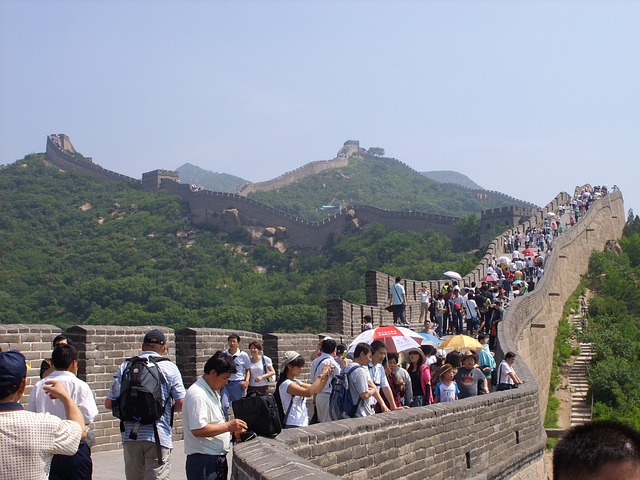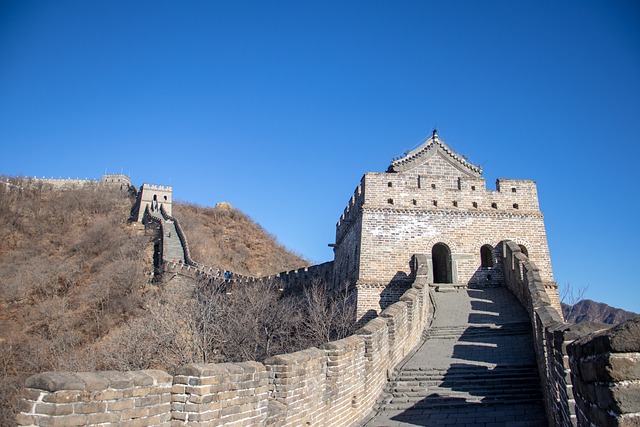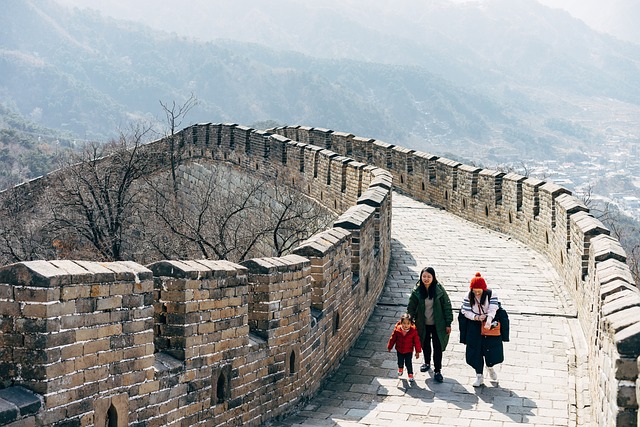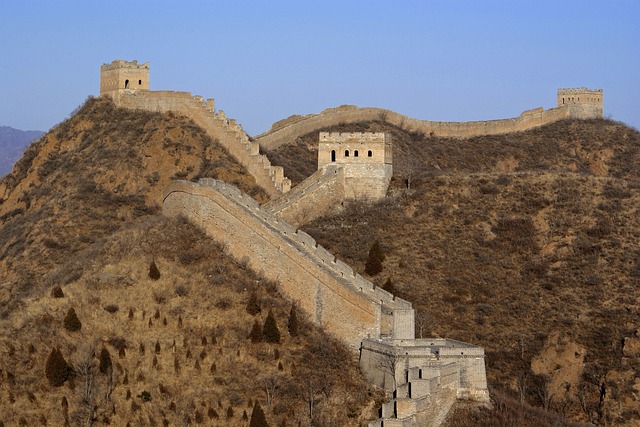Introduction to the Great Wall of China
The Great Wall of China mark the great achievement of Chinese people dated back to several centuries ago and runs from east to west of China touching the northern region. This longest building which has been constructed covering 13000000 sq meters is not only an architectural landmark of China but is a narration of the rich cultural and strategic and historical legacy of the great Chinese civilizations. Built through several dynasties it is the product of a nation and is inextricably linked with the history of the country.
Being constructed in different parts to different dynasties, the Great Wall of China was mainly functioning as a protective barrier to the Chinese states and empires from the northern invasions particularly by nomadic people who were always in quest of penetrating the Chinese realms. It was even in process from as far back as the 7th century BC and was extended till the period of the Ming dynasty (1368–1644 AD). Every dynasty added their works of architectures and militaries to build the wall and also to become the Great Wall of China we see today. Furnished with watchtowers, troop barracks, garrison stations and signaling through smoke or fire it played an important function in ancient warfare.
Speaking about the second conclusion, it sounds odd to say that the Great Wall of China was initially built for defense: this historical construction turned into a symbol of a culture that is familiar worldwide. It has been rightfully placed in the list of the New Seven Wonders of the World, which speaks volumes for its enormous importance, and wonder that arches even today. Besides, it is recognized at the international level as the world’s cultural heritage site since 1987 according to the UNESCO. Such a name brings culture and history to it and ties it with protection policies around the world for it to remain intact for the future generations. the Great Wall of China
Finally, this monument can be considered to be one of the most outstanding constructions of people due to the Great Wall’s tremendous length and architectural complexity. Not only is it a wall, however, it also becomes a bridge between history and today, conflict and harmony, division, and integration. Many tourists from all the corners of the world come to visit its preserved parts, as they would like to step on the ground which has the history of centuries.
Historical Background
Some of the greatest architectural marvels ever witnessed are the great wall of China which has had its early rooting as early as the seventh century BC. First of all, different feudal estates built these early walls for protection of the internal conflicts from the neighboring factions. Nevertheless, it was not until the Third Century B. C and under the reign of the first emperor of China, Qi Shi Huang that scattered walls were united and prolonged. This marks the start of what later would evolve to the Great Wall of China that we are familiar with presently.
However, huge additions of the wall were made in subsequent dynasties especially Han and Ming Dynasties. During the Han Dynasty (206 BC-220 AD), a huge number of constructions were made to defend the trade conduct routes of Silk Road from those nomadic tribes including the Xion gnu. These expansions were both for the purpose of military and economic gains needed in that period of history. The Great Wall of China then turned into icon representing powerful future Chinese empire and the technological present.
The most famous and recognized segment of the wall construction was done during the reign of the Ming dynasty which was between 1368-1644AD. Due to the relentless invasions by the Mongol, the Ming emperors concentrated on strengthening the Wall by the use of bricks and stone. During this period most of the famous features of the Wall including beacon tower, garrison station and command post were built. Emperor Hongwu and later on, Emperor Yongle were more particularly involved in the kinds of expansion that were made through this era.
The Great Wall of China has seen many historical events and climates in its existence and the Wall even was built in those times. It was used from there small fights and quarrels with nomadic tribes, to what it has become today; one of the greatest heritages of Chinese people. The Great Wall is not only a piece of architecture but also is a history of China’s resilience and its ability to stand up and rise again regardless of several adversities.
Architectural Marvels and Construction Techniques
It is with such a view that the great Wall of China remain impressive and a symbol of engineering and architectural past. Symbolizing the design and construction practices that defined various dynastic periods across the Mediterranean region, its Engineering combines the creative problem-solving approach that was employed at every period. The excellence of the Wall’s architecture is seen through arrangements; they built structure from available material like tamped earth, wood, bricks, and stone. Especially, the use of locally available materials such as quartzite rock from the mountainous area and granite blocks from the quarries in the project area depicted more of the local sensitiveness and utilization of locally available raw materials.
The people who created this colossal construction were numerous and therefore included soldiers, peasants, prisoners and other workers of the region. The number of people alone speaks volumes to the efforts and the things that have been laid down for centuries. The problems were more of an engineering nature and involved a range of values, these included differences in the geographical makeup of the region and the difficulties of moving materiel. Still, ancient engineers did not despair and came up with various ways and means to reduce the difficulties faced in construction pertaining to clinical and innovative methods of tamping for better and compact results for earthwork and durability. the Great Wall of China
The Wall had to be defensive and thus there are several strategic considerations that were taken into consideration when constructing this wall. There are watchtowers, battlements and beacon towers along its length as these were used for purposes of lookout and signaling. The watchtowers were built at equal distances and were very useful for accommodation of soldiers as well as the supplies. The parapets are the protective barriers that were given battlements to ensure that individuals have firing ledges for arrows or projectiles. Beacon towers for smoke signals in daytime and beacon fires at nighttime formed the pretentious of early warning system for distant places.
Development of construction methods was done during different dynastic periods as seen on this site. Among all times specially emphasizing the enhancement of fortification methods the Ming Dynasty deserve to be mentioned because new technologies of construction allowing using more reliable material such as bricks and mortars were used making the wall stronger and more endure. Learned from a combination of regional materials and labor efforts together with necessary defensive mechanisms, the Great Wall of China stands out as one of the greatest architectural masterpieces.
Cultural and Symbolic Significance
It is with such a view that the great Wall of China remain impressive and a symbol of engineering and architectural past. Symbolizing the design and construction practices that defined various dynastic periods across the Mediterranean region, its Engineering combines the creative problem-solving approach that was employed at every period. The excellence of the Wall’s architecture is seen through arrangements; they built structure from available material like tamped earth, wood, bricks, and stone. Especially, the use of locally available materials such as quartzite rock from the mountainous area and granite blocks from the quarries in the project area depicted more of the local sensitiveness and utilization of locally available raw materials.
The people who created this colossal construction were numerous and therefore included soldiers, peasants, prisoners and other workers of the region. The number of people alone speaks volumes to the efforts and the things that have been laid down for centuries. The problems were more of an engineering nature and involved a range of values, these included differences in the geographical makeup of the region and the difficulties of moving materiel. Still, ancient engineers did not despair and came up with various ways and means to reduce the difficulties faced in construction pertaining to clinical and innovative methods of tamping for better and compact results for earthwork and durability.
The Wall had to be defensive and thus there are several strategic considerations that were taken into consideration when constructing this wall. There are watchtowers, battlements and beacon towers along its length as these were used for purposes of lookout and signaling. The watchtowers were built at equal distances and were very useful for accommodation of soldiers as well as the supplies. The parapets are the protective barriers that were given battlements to ensure that individuals have firing ledges for arrows or projectiles. Beacon towers for smoke signals in daytime and beacon fires at nighttime formed the pretentious of early warning system for distant places.
Development of construction methods was done during different dynastic periods as seen on this site. Among all times specially emphasizing the enhancement of fortification methods the Ming Dynasty deserve to be mentioned because new technologies of construction allowing using more reliable material such as bricks and mortars were used making the wall stronger and more endure. Learned from a combination of regional materials and labor efforts together with necessary defensive mechanisms, the Great Wall of China stands out as one of the greatest architectural masterpieces.
The Great Wall in Modern Times
Also, in the present age the Great Wall of China prevails to interest the world due to its architectural brilliance and construction hard work. Today it is not only an important historical building, but it is already a perspective tourist object that attracts millions of people every year. The rising number of tourists A new generation of stakeholders, several preservation and restoration efforts are brought to the limelight due to rising tourism.
This area also has its challenges on how conservation can be done effectively for the great wall. The normal forces of erosion which include blowing wind rainwater and temperatures keep on exerting pressure on this wall and thus reducing its thickness in places, more so through natural processes, therefore requiring constant maintenance and repair. Also, human acts have also contributed to decline whereby sometimes the excess of tourism activities exposes the artefacts to vandalism and other structural deformities. Further, intrusion of urban expansion and agriculture poses threats to the Wall hence the need to protect this wonder of world heritage.
In order to meet these issues, there has been set both governmental and international efforts. The Chinese authorities have succeeded in putting different large-scale programs and projects in practice designed to protect and reproduce the Wall, it has been mended and strengthened, and its sections have been surrounded with barriers and tourist routes. These efforts have been supported by international cooperation through recognizing the Great Wall as a world heritage site which would draw international concern and money towards the conservation of the wall. Other groups and societies involved in awareness raising include the various non-governmental organizations, heritage organizations that publicize the historical importance of such a Wall and the importance of its conservation.
Non-commercial uses of the Great Wall of China today include great ceremonies and other cultural and sporting events, which make it further symbolical in respect with cultural values and longevity. Nevertheless, ensuring historical relevancy and integration of the facility into the modern context is a rather delicate matter, which calls for constant attention and involvement of all the parties concerned.
Thus, the Great Wall of China remains a living and steadfast example of human ancient ingenuity in today’s world with powerful programs to preserve them for future generations. A lot of effort has been made to ensure that it is preserved, and this is evidence by the fact that the world realizes the unmatched historic significance of the site.

Myths and Legends
One of the known and unique architectural structures in the world is the Great Wall of China which is about 13,000 miles, the great structure has a lot of myths and legends associated with it. These are probable oral histories that are rooted from narratives that make up the wall and give it a mystic touch that is historical as well as legendary. Among them, the Meng Jianghu story is one of the best-known; it narrates a story of a woman’s love and sacrifice.
The story of Meng Jianghu reflects a woman who lost her husband who was end muster to work on the great wall of the Qin dynasty. Finally, after months of waiting to see him, she ventured to follow her husband to the gold field and upon arriving she was informed by a doctor that her husband had died due to the harsh work and poor treatment he had been going through.
Touched by grief, Meng Jianghu cried inconsolably, and it is said that he weeping carved a portion of the Wall and Meng Jianghu was able to see bones of her husband. This legend speaks the great loss in terms of people’s lives in the construction of that great asset; The Great wall mirrors the ruined lives of the worthy and hardworking individuals who gave up their lives constructing the great asset known today as the great wall.
Another myth associated with Great Wall is that one can see Great Wall from space. Modern media spread this myth which originally began in the nineteenth century, even though there are proofs of this being false. Astronauts have dismissed this myth claiming that despite the Wall’s vast length, it is also very slim; it is colored in boluses that makes it hard to separate from the geology terrain without the help of a telescope.
Moreover, there are many tales that are devoted to the so-called ‘ghosts’ which are felt on the Wall area. It is said that a number of ghosts of the soldiers that were involved in its construction or workers who died in the process can still be seen to date. In doing so, these ghost stories make people recall that the Wall has a long history, and many people were killed there.
The myths and the legends surrounding the Great Wall of China only add to its enigma providing a new layer of meaning to it beyond what it is as a structure. Somehow, these narratives are interwoven into the very structure of the Wall providing it with a mission to not only represent a physical division but a triumph of people’s will, their blood, sweat and tears.
How to Visit the Great Wall
Therefore, planning when to visit the great wall of China can be a daunting task due to the avalanche of tourist sections that are available and the kind of experiences they offer. Both of the most visited part of the wall is Badaling and Mutiny which are famous for its tourist friendliness and perfect picture like appearance. Badaling is easily the most visited of the sections and contains tourist facilities such as cable cars; this makes it appropriate for all ages. Compared to it Mutiny is less tourist, but the views are just as spectacular and the paths are restored, so it is even more comfortable.
Preferably it is recommended to visit the Great Wall especially either in the early spring and late autumn since it has favorable climate, good weather and a nice backdrop. Summer is relatively hot and humid; the winter is extremely cold which also means when making treks the climate is very hostile. Taking appropriate clothes for the season, comfortable shoes especially for those who are planning to walk a lot and sun scream would improve your visit extremely.
Preparation is key. One should also pack some water, a few snacks, a mini first aid kit and clothing according to the changing weather. The ground is rugged with steep stairs and some rough trails; it is therefore advised to prepare physically particularly if one is planning to trek through narrow terrains. Some of the visitors consider using of the walking poles when getting up and down the slopes especially for balance.
For this purpose, one may sometimes consider hiring a local guide or go on a guided tour to maximize the learning process. These services provide relative history, stories, and other unnoticed facts that help to better understand the Wall. From the available choices, one can have the cheap group tours or he/she can have the more expensive individual tours which give one the chance to explore the place. Moreover, there are some tours that offer pick up and drop services to the Wall eliminating problems associated with logistics and providing convenience.
Visiting the Great Wall of China is not just going for a visit along the wall, but an historical trip that takes you back in time. This marvel is best experienced with a proper planning to soak in all that it represents in terms of history and architectural design.

The Impact of the Great Wall on Popular Culture
With interactive designs and an almost infinite amount of histories behind its construction the Great Wall of China is now indeed a part of a cultural fabric of people globally. It is evident that portrayals in movies, paintings, photographs and other forms of media have not only increased the awareness of this structure around the globe but has also placed this building not only as a symbol of New – York city but even the world at large.
In movie, Great Wall has become an centre of attention to many picture dramas. One of the most illustrative cases is the motion picture ‘The Great Wall’ released in 2016 and directed by Zhang Yimou with Matt Damon as the lead actor. Thus although the storyline is not extraordinary and brings fantasy memories, the use of the Great Wall made people learn about its existence and the mysteries that surround it. In addition, the Wall also featured in the famous animated film “Mulan” by Disney where it played a very noble role and underpinned the historical value of the structure.
Television programmes have especially not been left behind in the exploits of China and especially the majestic Great Wall. TV-shows like “The Amazing Race” filmed episodes where the contestants were required to complete tasks on the Wall and the massive length with beautiful views was perfectly demonstrated. This not only reminds the audience of the structural characteristics but also further imbeds it into the already familiar culture and concepts of those untutored on the history of this particular building.
Fiction also has not left out the Great Wall of China and has try to depict and describe the wall in their works. It has used in various novels from historical novel for instance Laurence Yep’s “Dragon’s Gate” to thriller novel like Clive Cussler “Treasure of Khan”. Such novels thus tie the readers with the myths, legends and history associated with the Wall and thereby enhance the understanding and value of the Wall to the readers.
Even in gaming the impacts of the great wall are clearly revealed. Therefore, common computer games including “Age of Empires II” and “Rise of Nations” have revealed the Great Wall as one of constructions that can be built by a civilization in a video game illustrating its strategical significance. In this way, the representations in the forms of communication and entertainment servers enhance the interaction and immersion , thus enhance the iconicity of the Wall.
The Great Wall of China is not only an ancient architectural masterpiece which helps people to develop their creativity, but a legendary cultural landmark that will forever remain significant for humanity. Its depiction across various media not only maintains the real-life architectural style in memory of today’s world but also brings out the story of mankind and strength to people across the world.



